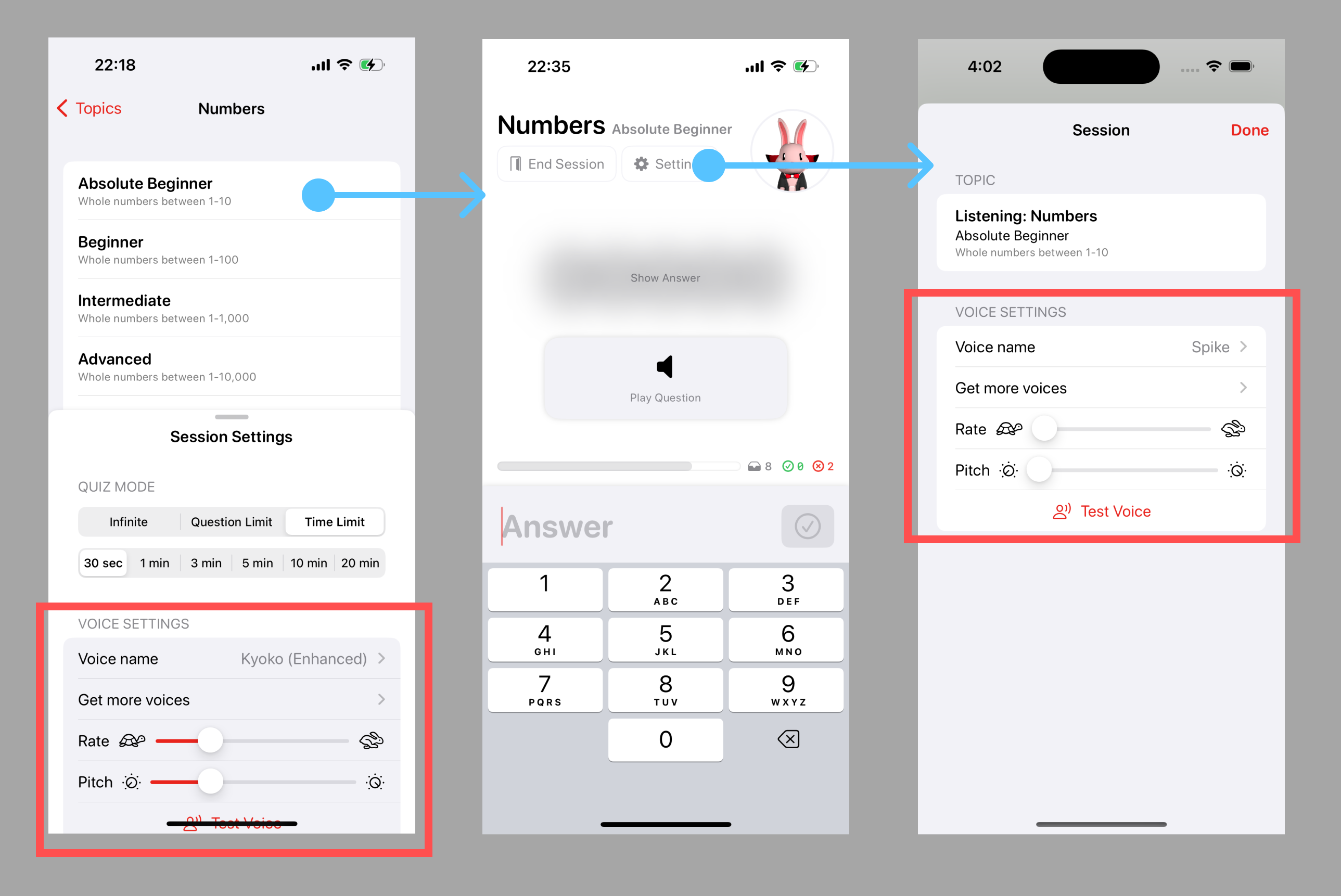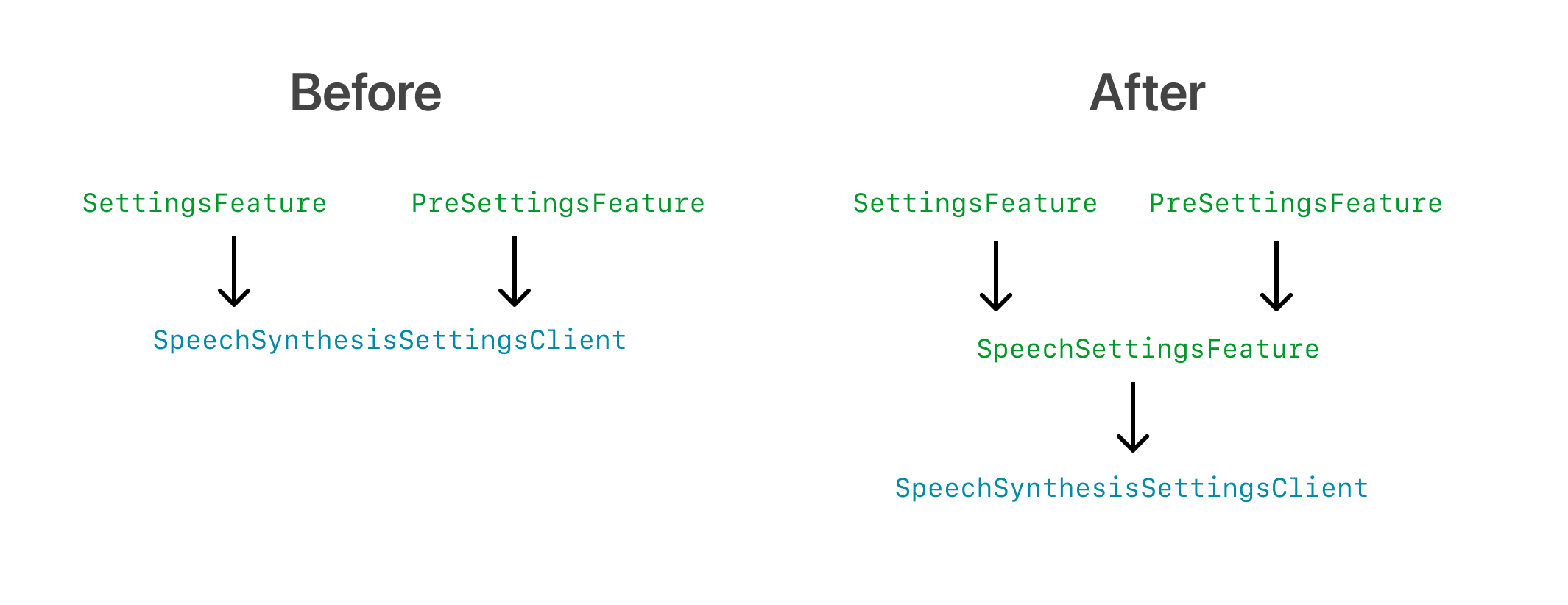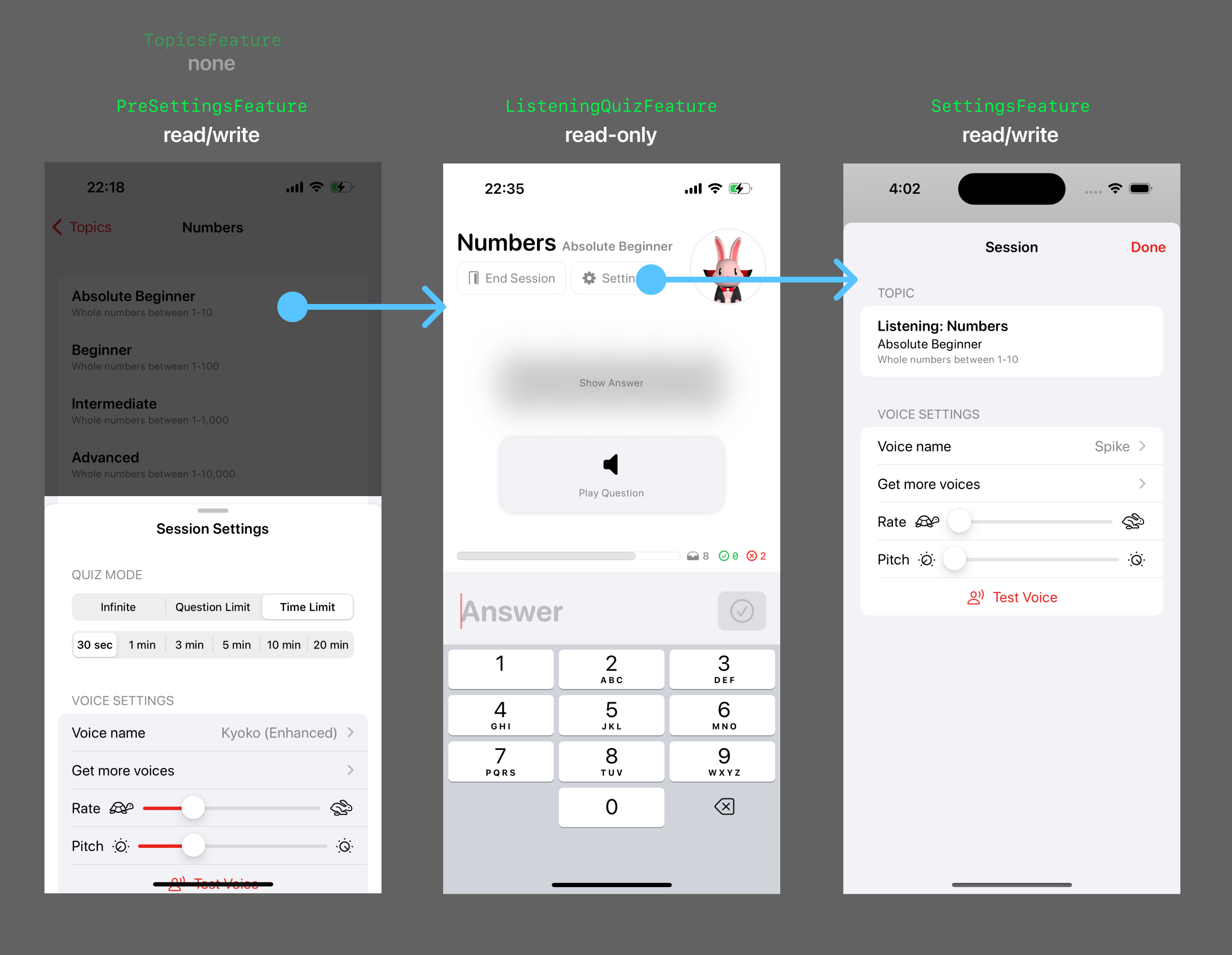Refactoring and Composing a Feature in The Composable Architecture
In this post, I’ll show an example of how I refactored a reusable feature/view pair from two screen-level reducers in my app Count Biki that uses The Composable Architecture (TCA). This post acts as a simplified walkthrough of the pull request on the project’s open source repo.
This has some similarities to the case study Reusable Favoriting, so please refer to that official example as well.
Background
Count Biki is my first App Store-released app using TCA. In my v1.0 release, I struggled to properly extend TCA concepts beyond just the basics illustrated in the case studies and example apps. I wrote about some of those lingering misunderstandings in this post too.
While working on the next set of features for the v1.1 and v1.2 releases, I’ve started to feel the dots start to connect regarding TCA. One of those is actually understanding reducer nesting to actually unlock the composability part of The Composable Architecture.
The goal of this post is to share a real world example of a small refactoring in hopes that it will help other TCA novices connect those same dots. And also solicit feedback from TCA veterans who may know better ways to accomplish the same refactorings I’ll present.
About the app and feature
Count Biki is a flashcard app for randomly generated Japanese numbers. The questions are audio read by the build-in text-to-speech (TTS)engine. The answers are numerals input by the user via the standard 10-key numeric keyboard.
A session is a set of questions presented to the user about one topic.
Before choosing a topic, the user can optionally configure some settings. Once the user starts a session by selecting a topic, they can configure a subset of settings related to voice and the TTS engine.

The voice settings are in their own List Section and require:
- logic to handle the bindings
- glue code to convert the view state to some
Codablestate - debounced writing to the persistence client
My first implementation of adding the pre-session setting screen was to simply duplicate both the view and reducer from the existing in-session settings feature. I did that (and a few other tasks) in the PR Add question/time limit quiz modes.
Goal
Our goal is to:
- refactor the duplicate code in the pre-session and in-session settings features for the voice settings into its own
ReducerandViewpair. - re-integrate this
SpeechSettingsFeatureandSpeechSettingSectionback into the pre-session and in-session settings features. - ensure any parent features that were relying on communication with either pre-session or in-session settings features still work as expected.

Refactoring
In-session SettingsFeature before refactoring
Let’s start by looking at a simplified version of the code from the in-session settings feature, named SettingsFeature before starting the refactor.
struct SettingsFeature: Reducer {
struct State: Equatable {
var availableVoices: [SpeechSynthesisVoice]
@BindingState var rawSpeechRate: Float
@BindingState var rawVoiceIdentifier: String?
@BindingState var rawPitchMultiplier: Float
let pitchMultiplierRange: ClosedRange<Float>
let speechRateRange: ClosedRange<Float>
var speechSettings: SpeechSynthesisSettings
let topic: Topic // assume the `Topic` is set
// The initial values for `speechSettings` are passed in from the parent feature. This feature is only responsible for modifying `speechSettings` in place, assuming the parent will monitor those changes.
init(speechSettings: SpeechSynthesisSettings) {
@Dependency(\.speechSynthesisClient) var speechClient
self.speechSettings = speechSettings
// Read and set valid ranges and default values from `speechClient`.
availableVoices = ...
speechRateRange = ...
pitchMultiplierRange = ...
// Set the initial "raw" values that are bound directly to the view layer from the input `speechSettings`.
rawVoiceIdentifier = ...
rawSpeechRate = ...
rawPitchMultiplier = ...
}
}
enum Action: BindableAction, Equatable {
case binding(BindingAction<State>)
case doneButtonTapped
case onSceneWillEnterForeground
case onTask
case pitchLabelDoubleTapped
case rateLabelDoubleTapped
case testVoiceButtonTapped
}
@Dependency(\.dismiss) var dismiss
@Dependency.Notification(\.sceneWillEnterForeground) var sceneWillEnterForeground
@Dependency(\.speechSynthesisClient) var speechClient
var body: some ReducerOf<Self> {
BindingReducer()
Reduce { state, action in
switch action {
case .binding(\.$rawSpeechRate):
state.speechSettings.rate = state.rawSpeechRate
return .none
case .binding(\.$rawVoiceIdentifier):
state.speechSettings.voiceIdentifier = state.rawVoiceIdentifier
return .none
case .binding(\.$rawPitchMultiplier):
state.speechSettings.pitchMultiplier = state.rawPitchMultiplier
return .none
case .binding:
return .none
case .doneButtonTapped:
return .run { send in
await dismiss()
}
case .pitchLabelDoubleTapped:
state.rawPitchMultiplier = speechClient.pitchMultiplierAttributes().defaultPitch
state.speechSettings.pitchMultiplier = state.rawPitchMultiplier
return .none
case .rateLabelDoubleTapped:
state.rawSpeechRate = speechClient.speechRateAttributes().defaultRate
state.speechSettings.rate = state.rawSpeechRate
return .none
case .onSceneWillEnterForeground:
// We expect the user will leave the app to download more voices and we should refetch
// voices from the system when the app returns to the foreground.
state.availableVoices = speechClient.availableVoices()
return .none
case .onTask:
return .run { send in
for await _ in sceneWillEnterForeground {
await send(.onSceneWillEnterForeground)
}
}
case .testVoiceButtonTapped:
// Use `speechClient` to speak a test phrase with the current `speechSettings`.
// ...
}
}
}
}
Nearly all the State and Action components are related to the speech settings. One method to start our refactor could be to rename the whole feature to SpeechSettingsFeature and extract the parent SettingsFeature elements from it.
But before we do that, let’s take a quick look at the view.
struct SettingsView: View {
let store: StoreOf<SettingsFeature>
var body: some View {
WithViewStore(store, observe: { $0 }) { viewStore in
NavigationStack {
Form {
Section {
// Topic-related views
// ...
} header: {
Text("Topic")
}
// Looks like almost all speech settings are contained within this `Section` besides the `.task` modifier.
Section {
if let $unwrappedVoiceIdentifier = Binding(viewStore.$rawVoiceIdentifier) {
Picker(selection: $unwrappedVoiceIdentifier) {
ForEach(viewStore.availableVoices) { voice in
Text(voice.name)
.tag(Optional(voice.voiceIdentifier))
}
} label: {
Text("Voice name")
}
.pickerStyle(.navigationLink)
NavigationLink {
GetMoreVoicesView()
} label: {
Text("Get more voices")
}
HStack {
Text("Rate")
.onTapGesture(count: 2) {
viewStore.send(.rateLabelDoubleTapped)
}
Slider(value: viewStore.$rawSpeechRate, in: viewStore.speechRateRange, step: 0.05) {
Text("Speech rate")
} minimumValueLabel: {
Image(systemName: "tortoise")
} maximumValueLabel: {
Image(systemName: "hare")
}
}
// Pitch settings slider (similar to rate above)
// ...
}
Button {
viewStore.send(.testVoiceButtonTapped)
} label: {
HStack(spacing: 10) {
Image(systemName: "person.wave.2")
Text("Test Voice")
}
.frame(maxWidth: .infinity, alignment: .center)
}
} else {
NavigationLink {
GetMoreVoicesView()
} label: {
HStack {
Text("Error: no voices found on device")
.foregroundStyle(Color.red)
}
}
}
} header: {
Text("Voice Settings")
.font(.subheadline)
}
}
// Toolbar-styling modifiers
// ...
}
.task {
await viewStore.send(.onTask).finish()
}
}
}
}
The SettingsFeature above looks very similar to the PreSettingsFeature, so I’ll only show the result of that refactor later.
In-session SettingsFeature after refactoring
Since SettingsFeature actually contains mostly SpeechSettingsFeature functionality, we’ll rename the SettingsFeature to SpeechSettingsFeature and then create a new SettingsFeature as the parent.
struct SettingsFeature: Reducer {
struct State: Equatable {
// `SettingsFeature` holds the source of truth for `SpeechSettingsFeature.State`.
var speechSettings: SpeechSettingsFeature.State
let topic: Topic // assume `Topic` is set
init() {
self.speechSettings = .init()
}
}
// This `Action` no longer needs `BindableAction` conformance.
enum Action: Equatable {
// `SettingsFeature` is only responsible for the `doneButton`.
case doneButtonTapped
// `SettingsFeature` forwards `SpeechSettingsFeature` actions to the child reducer.
case speechSettings(SpeechSettingsFeature.Action)
}
@Dependency(\.dismiss) var dismiss
var body: some ReducerOf<Self> {
// This scoping reducer is what's responsible for extracting the state and actions from the
// parent reducer `SettingsReducer` and passing them through to the child `SpeechSettingsFeature`.
Scope(state: \.speechSettings, action: /Action.speechSettings) {
SpeechSettingsFeature()
}
Reduce { state, action in
switch action {
case .doneButtonTapped:
return .run { send in
await dismiss()
}
case .speechSettings:
return .none
}
}
}
}
And the refactored SettingsView:
struct SettingsView: View {
let store: StoreOf<SettingsFeature>
var body: some View {
WithViewStore(store, observe: { $0 }) { viewStore in
NavigationStack {
Form {
Section {
// Topic-related views
// ...
} header: {
Text("Topic")
}
// We've refactored all this view code into `SpeechSettingsSection`.
// However, `SpeechSettingsSection` expects a store with type `StoreOf<SpeechSettingsReducer>`,
// so we have to scope the `StoreOf<SettingsFeature>` held by this view.
SpeechSettingsSection(
store: store.scope(state: \.speechSettings, action: { .speechSettings($0) })
)
}
// Toolbar-styling modifiers
// ...
}
}
}
}
You’ll notice that the .task modifier connected to the SettingsView’s NavigationStack lives as long as SettingsView. We’re using .task in the SpeechSettingsFeature to listen for app foreground changes. We want to do that with the same lifetime as SettingsView. However, since SpeechSettingsSection is a section within a Form/List/LazyVStack, its lifetime will be tied to its position within the internal ScrollView. But we want it to have the same lifetime as the parent. Therefore, we manually pass the .onTask modifier from parent to child above instead of implementing .onTask directly from SpeechSettingsSection to SpeechSettingsFeature. It’s a subtle difference that could lead to bugs depending the user’s scroll position.
SpeechSettingsFeature after refactoring
SpeechSettingsFeature looks pretty similar to our before-refactoring version of SettingsFeature, but let’s show the simple version of it after refactoring for completeness.
struct SpeechSettingsFeature: Reducer {
struct State: Equatable {
var availableVoices: [SpeechSynthesisVoice]
@BindingState var rawSpeechRate: Float
@BindingState var rawVoiceIdentifier: String?
@BindingState var rawPitchMultiplier: Float
let pitchMultiplierRange: ClosedRange<Float>
let speechRateRange: ClosedRange<Float>
var speechSettings: SpeechSynthesisSettings
init() {
@Dependency(\.speechSynthesisSettingsClient) var speechSettingsClient
@Dependency(\.speechSynthesisClient) var speechClient
self.speechSettings = speechSettingsClient.get()
// Read and set valid ranges and default values from `speechClient`.
availableVoices = ...
speechRateRange = ...
pitchMultiplierRange = ...
// Set the initial "raw" values that are bound directly to the view layer from the input `speechSettings`.
rawVoiceIdentifier = ...
rawSpeechRate = ...
rawPitchMultiplier = ...
}
}
enum Action: BindableAction, Equatable {
case binding(BindingAction<State>)
case onSceneWillEnterForeground
case onTask
case pitchLabelDoubleTapped
case rateLabelDoubleTapped
case testVoiceButtonTapped
}
private enum CancelID {
case saveDebounce
}
@Dependency(\.continuousClock) var clock
@Dependency.Notification(\.sceneWillEnterForeground) var sceneWillEnterForeground
@Dependency(\.speechSynthesisSettingsClient) var speechSettingsClient
@Dependency(\.speechSynthesisClient) var speechClient
var body: some ReducerOf<Self> {
BindingReducer()
Reduce { state, action in
switch action {
case .binding(\.$rawSpeechRate):
state.speechSettings.rate = state.rawSpeechRate
return .none
case .binding(\.$rawVoiceIdentifier):
state.speechSettings.voiceIdentifier = state.rawVoiceIdentifier
return .none
case .binding(\.$rawPitchMultiplier):
state.speechSettings.pitchMultiplier = state.rawPitchMultiplier
return .none
case .binding:
return .none
case .pitchLabelDoubleTapped:
state.rawPitchMultiplier = speechClient.pitchMultiplierAttributes().defaultPitch
state.speechSettings.pitchMultiplier = state.rawPitchMultiplier
return .none
case .rateLabelDoubleTapped:
state.rawSpeechRate = speechClient.speechRateAttributes().defaultRate
state.speechSettings.rate = state.rawSpeechRate
return .none
case .onSceneWillEnterForeground:
state.availableVoices = speechClient.availableVoices()
return .none
case .onTask:
return .run { send in
for await _ in sceneWillEnterForeground {
await send(.onSceneWillEnterForeground)
}
}
case .testVoiceButtonTapped:
let spokenText = "1234"
enum CancelID { case speakAction }
return .run { [settings = state.speechSettings] send in
await withTaskCancellation(id: CancelID.speakAction, cancelInFlight: true) {
do {
let utterance = SpeechSynthesisUtterance(speechString: spokenText, settings: settings)
try await speechClient.speak(utterance)
} catch {
assertionFailure(error.localizedDescription)
}
}
}
}
}
.onChange(of: \.speechSettings) { _, newValue in
// We've added a debounced save to disk action that runs on any change to `speechSettings`.
// This allows our feature to be more self-contained and reusable.
// Other features will have to rely on observing state from `speechSettingsClient`
// instead of passing it via actions through the reducer hierarchy.
Reduce { state, _ in
.run { _ in
try await withTaskCancellation(id: CancelID.saveDebounce, cancelInFlight: true) {
try await clock.sleep(for: .seconds(0.25))
do {
try speechSettingsClient.set(newValue)
} catch {
XCTFail("SpeechSettingsClient unexpectedly failed to write: \(error)")
}
}
}
}
}
}
}
And the Section:
struct SpeechSettingsSection: View {
// Note: the `store` is now specialized to `SpeechSettingsFeature` and must be
// properly scoped in the parent reducer.
let store: StoreOf<SpeechSettingsFeature>
var body: some View {
WithViewStore(store, observe: { $0 }) { viewStore in
Section {
if let $unwrappedVoiceIdentifier = Binding(viewStore.$rawVoiceIdentifier) {
Picker(selection: $unwrappedVoiceIdentifier) {
ForEach(viewStore.availableVoices) { voice in
Text(voice.name)
.tag(Optional(voice.voiceIdentifier))
}
} label: {
Text("Voice name")
}
.pickerStyle(.navigationLink)
NavigationLink {
GetMoreVoicesView()
} label: {
Text("Get more voices")
}
HStack {
Text("Rate")
.onTapGesture(count: 2) {
viewStore.send(.rateLabelDoubleTapped)
}
Slider(value: viewStore.$rawSpeechRate, in: viewStore.speechRateRange, step: 0.05) {
Text("Speech rate")
} minimumValueLabel: {
Image(systemName: "tortoise")
} maximumValueLabel: {
Image(systemName: "hare")
}
}
HStack {
Text("Pitch")
.onTapGesture(count: 2) {
viewStore.send(.pitchLabelDoubleTapped)
}
Slider(value: viewStore.$rawPitchMultiplier, in: viewStore.pitchMultiplierRange, step: 0.05) {
Text("Pitch")
} minimumValueLabel: {
Image(systemName: "dial.low")
} maximumValueLabel: {
Image(systemName: "dial.high")
}
}
Button {
viewStore.send(.testVoiceButtonTapped)
} label: {
HStack(spacing: 10) {
Image(systemName: "person.wave.2")
Text("Test Voice")
}
.frame(maxWidth: .infinity, alignment: .center)
}
} else {
NavigationLink {
GetMoreVoicesView()
} label: {
HStack {
Text("Error: no voices found on device")
.foregroundStyle(Color.red)
}
}
}
} header: {
Text("Voice Settings")
.font(.subheadline)
}
.task {
await viewStore.send(.onTask).finish()
}
}
}
}
Reconsidering parent/child communication
There’s actually one more step we can take that will reduce the complexity of parent-to-child reducer communication. It has to do with how we’re sharing the SpeechSynthesisSettings across features.
Let’s look at a visual of the features one more time:

Regarding hierarchy:
- There is a quiz navigation screen that acts as a wrapper for navigating between the 3 quiz screens. The quiz screen is a the root of a
NavigationStack. The summary screen can be pushed onto the stack. And the in-session settings is presented modally. This creates a layer of indirection between the quiz screen (which readsSpeechSynthesisSettings) and the in-session setting screen (which reads/writesSpeechSynthesisSettings). - The pre-session settings screen and quiz navigation screen are siblings, and their presentation is mutually-exclusive (only one is presented at a time).
- The in-session settings screen is a child of the quiz navigation screen.

Regarding read and write access to SpeechSynthesisSettings:
- The pre-session settings screen needs read/write access to
SpeechSynthesisSettings. - The quiz screen needs read-only access to
SpeechSynthesisSettings. - The in-session settings screen needs read/write access to
SpeechSynthesisSettings. - The quiz navigation screen needs no access to
SpeechSynthesisSettings.
Modeling this state is something I struggled with and wrote about in my initial post detailing the development of v1.0 of this app. Through the process of adding a few new features and refactoring, it’s become much clearer of the two different strategies to model this kind of state and the tradeoffs for each.
By “this kind of state” I mean state that is:
- shared with varying read/write access between parent/child/sibling features.
- persisted in some form.
I wrote about the two strategies to model state in TCA: root ownership and dependency ownership.
What I realized is that in the above refactoring, I had unnecessarily been mixing both root ownership and dependency ownership. Or, more precisely, I’d been superfluously using root ownership.
SettingsFeature and PreSettingsFeature did not need to hold onto and scope the state/actions of SpeechSettingsFeature because the source of truth for the underlying state of SpeechSettingsFeature is in the dependency SpeechSynthesisSettingsClient.
Let’s take a look at the changes to SettingsFeature after one more step of refactoring. I won’t show PreSettingsFeature because it’s basically the same.
struct SettingsFeature: Reducer {
struct State: Equatable {
- var speechSettings: SpeechSettingsFeature.State
let topic: Topic // assume `Topic` is set
init() {
- self.speechSettings = .init()
}
}
// This `Action` no longer needs `BindableAction` conformance.
enum Action: Equatable {
case doneButtonTapped
- case speechSettings(SpeechSettingsFeature.Action)
}
@Dependency(\.dismiss) var dismiss
var body: some ReducerOf<Self> {
- Scope(state: \.speechSettings, action: /Action.speechSettings) {
- SpeechSettingsFeature()
- }
Reduce { state, action in
switch action {
case .doneButtonTapped:
return .run { send in
await dismiss()
}
- case .speechSettings:
- return .none
}
}
}
}
struct SettingsView: View {
let store: StoreOf<SettingsFeature>
var body: some View {
WithViewStore(store, observe: { $0 }) { viewStore in
NavigationStack {
Form {
Section {
// Topic-related views
// ...
} header: {
Text("Topic")
}
SpeechSettingsSection(
- store: store.scope(state: \.speechSettings, action: { .speechSettings($0) })
+ store: Store(initialState: .init()) {
+ SpeechSettingsFeature()
+ }
)
}
// Toolbar-styling modifiers
// ...
}
}
}
}
We were able to remove some unnecessary code and complexity from both SettingsFeature and PreSettingsFeature. SpeechSettingsFeature is now a drop-in feature.
As discussed in the two strategies to model state post, there are tradeoffs to using the root ownership and dependency ownership strategies. In the case of SpeechSettingsFeature, dependency ownership seems like the most reasonable choice at the moment.
Conclusion
We succeeded in refactoring the duplicated functionality in SettingsFeature and PreSettingsFeature into one composable SpeechSettingsFeature. We also used this opportunity to convert the underlying state sharing strategy to dependency ownership.